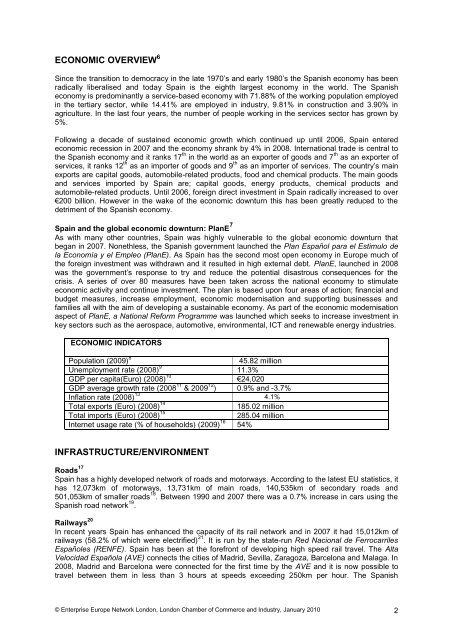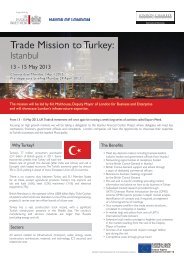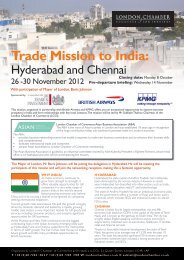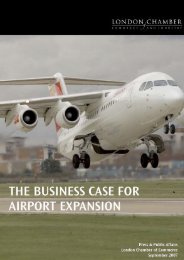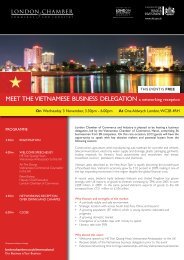ECONOMIC OVERVIEW 6Since the transition to democracy in the late 1970’s <strong>and</strong> early 1980’s the Spanish economy has beenradically liberalised <strong>and</strong> today <strong>Spain</strong> is the eighth largest economy in the world. The Spanisheconomy is predominantly a service-based economy with 71.88% <strong>of</strong> the working population employedin the tertiary sector, while 14.41% are employed in industry, 9.81% in construction <strong>and</strong> 3.90% inagriculture. In the last four years, the number <strong>of</strong> people working in the services sector has grown by5%.Following a decade <strong>of</strong> sustained economic growth which continued up until 2006, <strong>Spain</strong> enteredeconomic recession in 2007 <strong>and</strong> the economy shrank by 4% in 2008. International trade is central tothe Spanish economy <strong>and</strong> it ranks 17 th in the world as an exporter <strong>of</strong> goods <strong>and</strong> 7 th as an exporter <strong>of</strong>services, it ranks 12 th as an importer <strong>of</strong> goods <strong>and</strong> 9 th as an importer <strong>of</strong> services. The country’s mainexports are capital goods, automobile-related products, food <strong>and</strong> chemical products. The main goods<strong>and</strong> services imported by <strong>Spain</strong> are; capital goods, energy products, chemical products <strong>and</strong>automobile-related products. Until 2006, foreign direct investment in <strong>Spain</strong> radically increased to over€200 billion. However in the wake <strong>of</strong> the economic downturn this has been greatly reduced to thedetriment <strong>of</strong> the Spanish economy.<strong>Spain</strong> <strong>and</strong> the global economic downturn: PlanE 7As with many other countries, <strong>Spain</strong> was highly vulnerable to the global economic downturn thatbegan in 2007. Nonethless, the Spanish government launched the Plan Español para el Estimulo dela Economía y el Empleo (PlanE). As <strong>Spain</strong> has the second most open economy in Europe much <strong>of</strong>the foreign investment was withdrawn <strong>and</strong> it resulted in high external debt. PlanE, launched in 2008was the government’s response to try <strong>and</strong> reduce the potential disastrous consequences for thecrisis. A series <strong>of</strong> over 80 measures have been taken across the national economy to stimulateeconomic activity <strong>and</strong> continue investment. The plan is based upon four areas <strong>of</strong> action; financial <strong>and</strong>budget measures, increase employment, economic modernisation <strong>and</strong> supporting businesses <strong>and</strong>families all with the aim <strong>of</strong> developing a sustainable economy. As part <strong>of</strong> the economic modernisationaspect <strong>of</strong> PlanE, a National Reform Programme was launched which seeks to increase investment inkey sectors such as the aerospace, automotive, environmental, ICT <strong>and</strong> renewable energy industries.ECONOMIC INDICATORSPopulation (2009) 845.82 millionUnemployment rate (2008) 9 11.3%GDP per capita(Euro) (2008) 10 €24,020GDP average growth rate (2008 11 & 2009 12 ) 0.9% <strong>and</strong> -3.7%Inflation rate (2008) 13 4.1%Total exports (Euro) (2008) 14185.02 millionTotal imports (Euro) (2008) 15285.04 millionInternet usage rate (% <strong>of</strong> households) (2009) 16 54%INFRASTRUCTURE/ENVIRONMENTRoads 17<strong>Spain</strong> has a highly developed network <strong>of</strong> roads <strong>and</strong> motorways. According to the latest EU statistics, ithas 12,073km <strong>of</strong> motorways, 13,731km <strong>of</strong> main roads, 140,535km <strong>of</strong> secondary roads <strong>and</strong>501,053km <strong>of</strong> smaller roads 18 . Between 1990 <strong>and</strong> 2007 there was a 0.7% increase in cars using theSpanish road network 19 .Railways 20In recent years <strong>Spain</strong> has enhanced the capacity <strong>of</strong> its rail network <strong>and</strong> in 2007 it had 15,012km <strong>of</strong>railways (58.2% <strong>of</strong> which were electrified) 21 . It is run by the state-run Red Nacional de FerrocarrilesEspañoles (RENFE). <strong>Spain</strong> has been at the forefront <strong>of</strong> developing high speed rail travel. The AltaVelocidad Española (AVE) connects the cities <strong>of</strong> Madrid, Sevilla, Zaragoza, Barcelona <strong>and</strong> Malaga. In2008, Madrid <strong>and</strong> Barcelona were connected for the first time by the AVE <strong>and</strong> it is now possible totravel between them in less than 3 hours at speeds exceeding 250km per hour. The Spanish© Enterprise Europe Network <strong>London</strong>, <strong>London</strong> <strong>Chamber</strong> <strong>of</strong> <strong>Commerce</strong> <strong>and</strong> <strong>Industry</strong>, January 2010 2
government has set a target <strong>of</strong> laying 10,000km <strong>of</strong> train lines for high-speed trains by 2020 <strong>and</strong> thiswould make it the most developed in Europe. Seven high-speed train lines are currently underconstruction <strong>and</strong> will be opened in 2012 connecting cities such as Murcia, Vigo, La Coruna, Granada,Bilbao <strong>and</strong> Sant<strong>and</strong>er, which until now have not been connected to the high-speed lines 22Shipping 23Given <strong>Spain</strong>’s strategic geographical location <strong>and</strong> being a country with a coastline <strong>of</strong> 8,000km,shipping plays a crucial role in the transport infrastructure <strong>of</strong> the country. There are 53 ports locatedon both the Atlantic <strong>and</strong> Mediterranean coasts <strong>and</strong> <strong>Spain</strong> is ranked fourth in sea freight transportation(behind the United Kingdom, Italy <strong>and</strong> the Netherl<strong>and</strong>s) 24 According to <strong>of</strong>ficial statistics for 2007, 59%<strong>of</strong> <strong>Spain</strong>’s exports <strong>and</strong> 82% <strong>of</strong> its imports passed through Spanish ports. Shipping contributes to 20%<strong>of</strong> the transport sector’s GDP <strong>and</strong> 1.1% <strong>of</strong> the national GDP. The importance <strong>of</strong> shipping is alsoreflected in the role it plays in its foreign trade (53% <strong>of</strong> trade with other EU countries is throughshipping <strong>and</strong> 96% <strong>of</strong> trade with third countries). The ports <strong>of</strong> Algeciras, Barcelona <strong>and</strong> Valencia arethe main shipping terminals in <strong>Spain</strong>. Between 2000 <strong>and</strong> 2005, <strong>Spain</strong> saw the largest annual growth<strong>of</strong> short-sea shipping in the EU (an 8.3% increase compared with the EU average <strong>of</strong> 3.5%) 25 .Civil aviation 26In 2008, 203.8 million passengers travelled through Spanish airports. This was an increase <strong>of</strong> 45%from the passenger numbers in 2000. There are 49 airports in <strong>Spain</strong> <strong>and</strong> 250 airline companies useSpanish airports 27 . In 2008, the busiest airport was Madrid-Barajas which processed 50.85 millionpassengers, followed by Barcelona which accommodated 30.21 million. They are the fourth <strong>and</strong>eighth busiest airports in the EU respectively 28 . The main Spanish airline is Iberia which took 24million passengers <strong>of</strong> the total market share.Energy 29The three main sources <strong>of</strong> energy used in <strong>Spain</strong> are oil, natural gas <strong>and</strong> nuclear energy. In 2008, 48%<strong>of</strong> the country’s energy came from oil <strong>and</strong> this constitutes the number one energy source. Howeverthe use <strong>of</strong> petrol as a primary source <strong>of</strong> energy has fallen <strong>and</strong> between 2007 <strong>and</strong> 2008 it fell by 3.9%.While in 2008 <strong>Spain</strong> consumed 68.1 million tonnes it only produced 127 000 tonnes <strong>and</strong> the majority<strong>of</strong> oil is imported.Natural gas is the second main source <strong>of</strong> energy. In 2008, 450 726KWh was used, which was a 10%increase <strong>of</strong> the previous year. The increased use <strong>of</strong> natural gas as a primary source has beenattributed to <strong>Spain</strong>’s growing environmental awareness as well as the competitiveness <strong>of</strong> Spanish gassuppliers such as Gas Natural <strong>and</strong> Endesa which have benefited from liberalised markets.Nuclear energy has become an increasingly used source <strong>of</strong> energy. <strong>Spain</strong> has six nuclear powerstations <strong>and</strong> is the source <strong>of</strong> 18.9% <strong>of</strong> the nation’s energy.Telecommunications 30In recent years liberalisation <strong>of</strong> the telecommunications market in <strong>Spain</strong> has opened up the market toother companies <strong>and</strong> has reduced the monopoly that the former state-run company Telefonicapreviously held. Telecommunications had an annual turnover in 2007 <strong>of</strong> €50.288 million (compared to€44.603 million in 2005) 31 . The mobile phone industry saw an increase <strong>of</strong> 5.9% in the number <strong>of</strong>mobile phone subscriptions between 2003 <strong>and</strong> 2008, while the number <strong>of</strong> l<strong>and</strong>lines in the countryincreased in the same period by 2.6% (which was the third highest increase in EU <strong>and</strong> 18 EUcountries saw a decrease in the number <strong>of</strong> l<strong>and</strong>lines) 32 .Other companies have entered into the growing mobile phone market such as Orange <strong>and</strong> Vodafone.In recent years there has also been a rapid expansion in the broadb<strong>and</strong> internet network in <strong>Spain</strong>through the Avanza Infrastructures Programme. Due to the fact that 50% <strong>of</strong> the country is covered bymountains, broadb<strong>and</strong> access is not as widespread in rural areas as it is in urban areas. Thegovernment is increasing access to high-speed broadb<strong>and</strong> <strong>and</strong> investing over €55 million in thetechnology required 33 .Environment 34In 2006, <strong>Spain</strong> had the highest greenhouse gas emissions in the whole <strong>of</strong> the EU <strong>and</strong> its target forcutting emissions is the third most generous for all member states 35 . In the last decade <strong>Spain</strong> hasbenefited from €12,357 million to improve the environmental <strong>and</strong> transport infrastructure <strong>of</strong> thecountry 36 . Water management has been one <strong>of</strong> the most pressing dem<strong>and</strong>s on the Spanish© Enterprise Europe Network <strong>London</strong>, <strong>London</strong> <strong>Chamber</strong> <strong>of</strong> <strong>Commerce</strong> <strong>and</strong> <strong>Industry</strong>, January 2010 3


